by Amineddoleh & Associates LLC | Jul 20, 2020 |
For decades, art institutions have struggled to find a compelling response to concerns raised over owning and possessing art and antiquities taken and exported during periods of colonialism. Critics argue that it is unethical to continue holding works that were sourced during times of conflict or subjugation, and often taken as trophies of war or as symbols of power over foreign subjects. By doing so, it deprives the original owners of their rights. Critics also argue that displaying these objects in a foreign museum strips them of essential cultural context. While the debate over such works is nothing new (nations such as Greece, Egypt, India and China have been seeking repatriation of objects for decades), recent protests against racial injustice across the globe have brought the conversation out of museum boardrooms and into the spotlight.
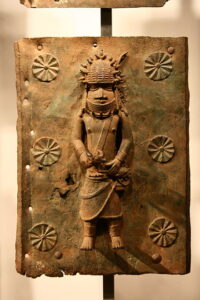
One of the Benin Bronzes at the British Museum. Copyright: British Museum
As museums across Europe begin to reopen, Dan Hicks, a professor and senior curator at the Pitt Rivers Museum in Oxford, has begun the arduous tasking of evaluating the museum’s collection of more than 600,000 works representing almost every country across the globe. Hicks acknowledges that displaying works of cultural significance without proper context risks telling a revisionist version of history. The professor has received acclaim for his efforts to re-introduce the museum’s collection to the public from the perspective of the works’ countries of origin. “This is very specifically about a period of time when our anthropology museums were used for purposes of institutional racism, race science, the display of white supremacy. At this moment in history, it could not be more urgent to remove such icons from our institutions.” Hicks also believes in deaccessioning and returning works that were illicitly seized, including notable objects such as the Benin Bronzes. The bronzes, which are found in many prominent museums around the world, were seized by British soldiers during a punitive raid on the Kingdom of Benin in 1897 (modern day Nigeria). To Hicks, the decision is simple: “It is a matter of respect and being treated equally. If you steal people’s heritage, you’re stealing their psychology, and you need to return it.” It remains to be seen whether museums will adopt this approach as the public continues applying pressure on museums to reconcile with a troubling past.
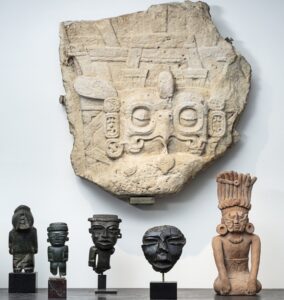
The large carved relief showing a Maya king’s headdress with an owl motif is among works to be sold at auction in Paris. Copyright: Millon and Assoc.
It is important to note that this problem is not exclusive to European countries with an imperialistic past; culturally significant works are still being looted and sold on the open market today. In particular, works from Africa and South America are becoming increasingly popular among art collectors, bringing stolen or looted works to the surface of the market. Amineddoleh & Associates LLC recently discussed two such works which were sold at auction in Paris despite claims that they were looted in violation of local law. In contrast, another French auction house recently pulled a Mayan sculpture from its sale after allegations that the piece was clearly stolen spurred public outcry. Archeologists had previously documented the piece at the ancient city of Piedras Negras, in modern day Guatemala, placing its export during the 1960s and virtually eliminating the possibility that it was exported legally. The Guatemalan Embassy in Paris released a statement once it was agreed the work would be withdrawn stating that negotiations with the sellers were underway. The close proximity of these two sales with different outcomes demonstrates that countries have not yet determined a reliable means of repatriating looted artwork. The significance of this issue was underscored recently as an Interpol sting led to the seizure of approximately 19,000 stolen artifacts, including pre-Columbian relics, suggesting the illicit market for such goods is thriving. In fact, just last year a French auction house sold dozens of Mexican artifacts, despite Mexico’s demand for their return. Hopefully, countries will find it easier to have culturally significant works returned as the public becomes more aware of the issue and ask institutions to be held accountable.
Collectors must also be aware that purchases of cultural artifacts may be legal at the time of sale, but subject to scrutiny and criticism later on. It is imperative to consult knowledgeable professionals before adding potentially questionable items to a collection, whether public or private. Amineddoleh & Associates prides itself on its knowledge of the art and cultural heritage market, and we assist collectors and purchasers in carrying out responsible transactions.
by Amineddoleh & Associates LLC | Apr 5, 2022 |
In our spring newsletter, Amineddoleh & Associates LLC is pleased to share some exciting developments that took place at the firm during the past winter.
LITIGATION UPDATES

The mural in Des Moines, Iowa shown in the Super Bowl commercial.
Chris “CAW” Williams, Maze, 2018
Amineddoleh and Associates LLC is representing Iowa-based muralist Chris Williams in a case against the Midwest grocery chain, Hy-Vee. Williams’ mural in downtown Des Moines, Iowa was featured in a 2019 Superbowl advertisement promoting Hy-Vee’s partnership with Oprah Winfrey’s O, That’s Good! Brand without the artist’s authorization. The case involves copyright law and VARA (the Visual Artists Rights Act), given the defendants’ unlicensed use of the image and lack of credit to Williams as the artist of the mural. The lawsuit seeks damages for the unlawful commercial use and appropriation use of Mr. Williams’ work. Read about the litigation in an article published by The Art Newspaper here and for more details, you can go to our website.
ART & IP NEWS
Cultural Heritage and Art in Ukraine
The world watched anxiously as tensions rose, and then erupted, between Russia and Ukraine in late February. The conflict between Russia and Ukraine has led to the most tragic casualty, the widespread loss of human lives. As this horror unfolds, art world professionals are also concerned about the loss of art and heritage while the conflict rages. We published a blog post delving into the risks to art collections, museums, cultural sites, as well as other art and heritage in Ukraine posed by the conflict. It is available here. Several days later, we were disheartened to confirm that the conflict resulted in the destruction of 25 artworks by renowned Ukrainian artist, Maria Prymachenko, after a museum in Ivankiv burned down.
Restitution of Mexican Antiquities
Cultural heritage is also at risk across the Atlantic Ocean. We published a blog post discussing how Pre-Columbian/Pre-Hispanic objects are often looted or smuggled from Latin America due to their high resale value and sold abroad. Recently, however, Mexico has taken several steps to recover its cultural artifacts and enforce national patrimony laws. Read more about the restitution of Mexican antiquities and the role of international cooperation on our website.
Dealer with Ties to Looted Antiquities Detained in Paris
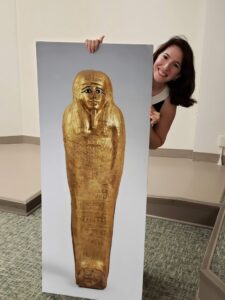
Leila Amineddoleh at the repatriation ceremony in 2020 in her role as the Egyptian cultural heritage law expert.
Roben Dib, a dealer suspected of supplying high-profile museums (including the Metropolitan Museum of Art in New York and the Louvre Abu Dhabi) with looted antiquities, was recently transferred to France to face charges of gang fraud and money laundering. Authorities believe that Dib acted through an intermediary (expert Christophe Kunicki) to engage in the large-scale trafficking of looted artifacts from Egypt and the Middle East. Previously, Kunicki had sold a looted golden sarcophagus to the Metropolitan museum for €3.5 million. A subsequent criminal investigation by Assistant District Attorney Col. Matthew Bogdanos exposed serious flaws in the museum’s provenance research, after which the museum issued an apology and formally repatriated the sarcophagus. Our founder served as the Egyptian cultural heritage law expert in this matter and attended the repatriation ceremony in 2020. You can read more about the sarcophagus’ journey here.
LAW FIRM UPDATES AND EVENTS
Art Law Conferences
In March, our firm’s founder, Leila Amineddoleh, served as a panelist at Notre Dame’s Journal of International and Comparative Law Symposium. At the symposium, “International and Comparative Approaches to Culture”, Leila discussed antiquities disputes and repatriation of cultural heritage.
At the end of March, Leila served as the keynote speaker at Yale University’s conference, “Dura-Europos: Past, Present, Future.” This event focused on the systematic looting of Dura-Europos that took place during the Syrian civil war. Specifically, Leila presented on the history of cultural heritage looting and modern efforts to prevent such plunder. Read more about this conference here.

Examples of Benin Bronzes, looted art from Africa at the center of repatriation discussions.
Photo courtesy of Getty Images
Additionally, in January Leila participated in the webinar “Repatriation of African Artifacts: A Challenge for History and Property Rights,” hosted by African Liberty. The restitution of looted artifacts from Africa has formed part of an ongoing debate in several countries, particularly in Europe and the US (as former colonial powers). Leila discussed the recent focus on remedies for these issues, particularly the repatriation of the objects to their countries of origins and the grounds for doing so. We previously explored the subject of the Benin Bronzes in our ongoing Provenance Series, which you can access here.
Upcoming Conferences
This spring, we have additional conferences at which members of our firm will be speaking to look forward to.
Our associate, Claudia Quinones, will be presenting at a workshop organized by The European Society of International Law (ESIL) Interest Group ‘The EU as a Global Actor’ (IG EUGLOBAL). The event will be hosted by the University of Glasgow and focuses on “International Law and Global Security: Regulating an Illusion?”. Specifically, Claudia will speak on ‘Cultural Protection as a Key Component of Global Security.’ Information about the event can be found here.
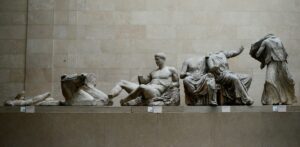
The Parthenon Marbles on display at the British Museum in London.
Photo Credit: Dylan Martinez/Reuters
Leila will also bring her expertise as a speaker to the 28th Annual Cultural Property Conference at Cardozo School of Law. As part of a panel on cultural property and international human rights trends, Leila will discuss the policies and polities of the Parthenon Marbles. Register and read more about this conference here, and learn more about the Parthenon Marbles on our website.
We look forward to both Leila’s and Claudia’s discussions at these upcoming events.
Art Law Publications
A number of recent cases have left some artists uneasy about the scope of the Fair Use Exception and the use of copyrighted materials in appropriation art. This has led to a shift in the landscape of copyright law. In fact, last month the U.S. Supreme agreed to hear arguments in the closely-watched case involving the Warhol Foundation. Leila commented on these shifts to the legal landscape in an article she wrote for the Institute of Art & Law titled “Fair Use in US Law: The Path to Marano v. Metropolitan Museum of Art.” Please contact us or the Institute of Art & Law for a copy of Leila’s informative article.
Associate Claudia Quinones was also published in the Santander Art and Culture Law Review (SAACLR). Her article, “On the Borderline – Using National and International Legal Frameworks to Address the Traffic of Pre-Columbian Antiquities between Mexico and the United States,” discusses historical and recent approaches to the illicit traffic of antiquities originating in Mexico. It further explores legal and non-legal remedies to curb this traffic. You can read her article on the SAACLR website.
CLIENTS AND REPRESENTATIVE MATTERS
Leader in the NFT Market

World’s first NFT vending machine
As discussed in our last newsletter, Amineddoleh and Associates has been one of the first law firms to work in the NFT space – both through our creation of the unique purchase and sale agreement for NFTs. Our clients include Monax, Nifty Gateway, private buyers and sellers, and corporations involved in investing in these assets. Our founder has also participated in a number of conferences focused on this topic, at locations including the University of Zurich, the Foundation for Art Law, and the New Museum in New York City.
As NFTs continue to dominate the art market, Leila had the opportunity to talk with the Associated Press about the world’s first NFT vending machine.
Music Spotlight
Art law encompasses any artistic expressions, including music. We have written a number of blog posts discussing the protection of musical instruments as well as the provenance of musical instruments and manuscripts. Given our passion for the subject, we are excited to announce that Amineddoleh and Associates is currently working on a number of music related matters.
The first matter involves valuable stolen classical music instruments which we are seeking to return to their rightful owner (our client).
In addition to working with a number of high-profile clients on their intellectual property portfolios, our firm is also representing Danish-born producer and songwriter Jonas Jeberg, known for writing and producing songs like Panic! At the Disco’s “High Hopes”, the Jonas Brothers’ “Rollercoaster,” Demi Lovato’s “You Don’t Do It For Me Anymore,” and Selena Gomez’s “Fetish” ft. Gucci Mane, as well as many others. Amineddoleh and Associates is advising Jeberg on his trademark portfolio.
Upcoming Happenings
After our client’s successful sale of a work by David Hammons at Sotheby’s in March (a sale that realized a price greater than the projected estimate), our client has three additional works that will be up for auction at Sotheby’s Contemporary Evening Sale in May. We look forward to attending this auction as the art market continues its post-pandemic upswing.
by Amineddoleh & Associates LLC | Dec 17, 2020 |
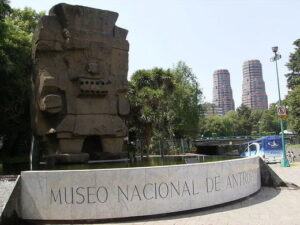
Monolith of Tlaloc
As many nations around the world prepare for Christmas, this week’s blog post examines an art heist that took place at the Museum of Anthropology in Mexico City on Christmas in 1985. On that day, unknown assailants snuck into the museum before dawn and removed 140 objects hailing from the Mayan, Aztec, and various other native Mexican communities. Because of the objects’ small size (nearly all of them were around 1 inch in size) they were easily removed and transported. The stolen artifacts included a jade mosaic funerary mask and an obsidian monkey-shaped vase worth over $20 million. The thieves knew what they were after, since they took the best objects from each display.
Museum curator Felipe Solís bemoaned the theft as a national tragedy: “[The thieves] robbed a piece of our history. How can we put a price on it?” Similar to the infamous Isabella Stewart Gardner Museum theft in Boston on St. Patrick’s Day in 1990 (when the city of Boston was in the midst of holiday celebrations), the Mexico City heist seems to have been a combination of planning and circumstance. Not only did it take place early on Christmas Day, a holiday widely celebrated across the country that would make the museum vulnerable that day, the museum’s alarm was faulty and the 9 security guards working that day apparently got drunk during the night, as evidenced by cookies and glasses with liquor residue found at the museum.
Fortunately, unlike the Isabella Stewart Gardner case, the thieves were found and all the items were recovered three years later. At the time, the director of collections of the Los Angeles County Museum of Natural History noted that it was like “trying to fence the Mona Lisa.” A former dealer opined that “no reputable dealer” would go near the loot. Many industry professionals were also concerned that the thieves would destroy the artifacts if they went unsold (something often done in order to destroy evidence connecting thieves to their misdeeds). Although the targeted nature of the theft initially led Mexican officials to conclude that seasoned professionals – potentially KGB agents – were responsible and that the objects had been exported immediately to the U.S. for sale, the truth was far different. In fact, it was a pair of amateurs (university dropouts, to be exact) who carried out the robbery. The thieves visited the museum over 50 times before jumping over the fence, crawling through an air-conditioning duct, and looting seven display cases.

Replica of Montezuma’s Headdress (in Museo Nacional de Antropología e Historia, Mexico City)
As one of the largest Pre-Columbian artifact thefts in history, the heist had a profound impact on the collective imagination, spurring a 2017 film titled Museo (Museum) which stars Mexican actor Gael García Bernal. The film recognizes that the Christmas Day theft was not the first instance of plunder from Mexico because the indigenous people of the nation had long faced the tragic theft of their heritage. Quite poignantly, Museo opens with footage of the removal of the Monolith of Tlaloc (the Aztec god of rain). It was discovered in the late 19th century in Coatlinchan, but in 1964 the 168-ton statue was moved to Mexico City to be displayed outside the National Museum of Anthropology. In doing so, the revered statue was removed from its original home, and some locals even protested the move. The film makes several references to the theft of indigenous items of cultural significance, including the statement that Montezuma’s headdress in the Mexico City museum is a copy because the original was “already stolen.” The famed headdress, made of nearly 500 quetzal feathers with sewn-on gold detailing, was removed from Mexico, mostly likely during the 16th century. It likely traveled to Spain, and then ended up in an Austrian collection in Innsbruck in the 1590s. It eventually became part of the Museum of Ethnology in Vienna, Austria. In 1991, the Mexican government formally requested the return of the treasure, but the Austrian museum declined, stating that it was not possible to safely return the cultural jewel. The ownership over this piece is still a source of contention between Austria and Mexico.
Pre-Colombian artifacts have become increasingly popular among collectors, fetching millions of dollars at auction – though not without controversy. In September 2019, a French auction house proceeded with the sale of dozens of such artifacts despite concerns from the Mexican and Guatemalan governments that the items were looted. The lots sold for $1.3 million, twice the initial estimate. These artifacts have also been subject to wider debates on colonialism and illicit trafficking. Now more than ever, it is crucial for collectors, purchasers, and sellers of art and antiques, including archaeological pieces, to do their due diligence and establish the provenance of items. At Amineddoleh & Associates, we assist clients with this process every step of the way, ensuring that transactions comply with applicable regulations so that they can enjoy their collections with peace of mind.
The Amineddoleh & Associates team wishes you all a Merry Christmas and Happy Holidays…without art thefts!








